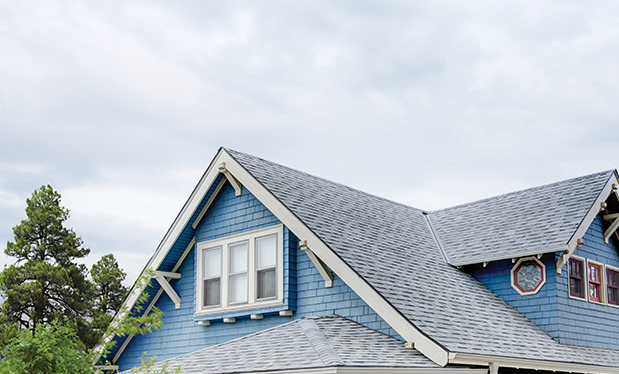Since 2004, NRCA and the Midwest Roofing Contractors Association have worked together to improve roofing torch safety through the Certified Roofing Torch Applicator (CERTA) program. Although the CERTA program primarily addresses how experienced roofing workers should safely use roof torching equipment, proper roof system design, material selection and construction details also are essential elements in fire-safe torch-applied roof system applications.
If you are involved in the design and specification, product manufacturing or distribution, or application of torch-applied polymer-modified bitumen membrane roof systems, you should be aware of the CERTA program and its essential elements.
CERTA training
CERTA's daylong training program consists of teaching experienced roofing workers how to safely use torches when applying polymer-modified bitumen membrane roofing products. Participants are taught how to use personal protective equipment and first-aid procedures specific to torching activities, torch equipment safety, rooftop fire hazard identification and mitigation, and post-torch work fire-watch techniques.
NRCA offers train-the-trainer classes to authorize CERTA trainers to conduct CERTA classes for applicators. Since 2004, more than 1,900 trainers have been authorized to conduct CERTA classes, and they have trained more than 29,300 CERTA-authorized applicators. Individual applicators hold NRCA-issued CERTA cards, which identify them as CERTA-trained authorized applicators.
CERTA trainers are identified on the CERTA website, www.certa.org, by clicking on the "Find a CERTA Trainer" link. Roofing contractors who employ CERTA-authorized applicators are identified on the CERTA website by clicking on the "Find a company with CERTA applicators" link.
The training program's cornerstone is CERTA's best safety practices, which identify time-tested, proven safe torching techniques. For example, the best practices stipulate torch-applied roofing products not be applied directly to combustible roof decks (plywood, oriented strand board, wood planks, wood boards), wood fiberboard insulation, wood blocking or combustible flashing substrates at construction details. The best practices prescribe specific techniques that can be used for addressing these conditions. The NRCA Roofing Manual provides additional guidance.
The CERTA best safety practices also require a fire watch to be conducted by a dedicated individual for a minimum of two hours immediately after torching operations have ceased to identify possible ignition sources or smoldering materials. If torching operations are interrupted during the workday, such as during a break or lunchtime, a fire watch should commence immediately at the beginning of and continue through the interruption. Whenever possible, accessing the building's interior to visually check the bottom of the roof deck in the torch work area should be included in a proper fire watch.
The CERTA best safety practices are contained in the CERTA student manual, which is accessible under the "Trainer resources" link on the CERTA website.
Design considerations
In addition to the fire-safe application techniques prescribed by the CERTA training program, proper roof system design, material selection and construction detail configurations also are essential elements of fire-safe, torch-applied, polymer-modified bitumen membrane roof system applications.
The roof system designer is responsible for clearly delineating the intended roof system design, material selection and construction detail configurations in a project's drawings and specifications. The decision to use a roof system type and specific roofing products installed using the torch application technique is made by the roof system designer.
It is important to realize some torch-applied roofing product manufacturers' roof system configurations, construction details and warranty requirements are not consistent with CERTA program guidelines.
NRCA recommends CERTA's best safety practices, in conjunction with the guidelines contained in The NRCA Roofing Manual, be used when designing and applying torch-applied, polymer-modified bitumen membrane roof systems.
NRCA provides specific roof system design and material selection guidelines for torch-applied, polymer-modified bitumen membrane roof systems in Chapter 1-Roof System Configurations of The NRCA Roofing Manual: Membrane Roof Systems. Six torch-applied product-specific roof system configurations are provided: four are applicable to new construction or roof replacement projects, and two are applicable to existing roof re-cover projects.
APP Polymer-modified Bitumen Roof Systems, Two-layer, Torch-applied, Nonnailable Deck and SBS Polymer-modified Bitumen Roof Systems, Two-layer, Torch-applied, and Nonnailable Deck apply to APP- or SBS-polymer modified bitumen roof systems, respectively, installed over nonnailable (concrete) roof decks. With each configuration, a torch-applied polymer-modified bitumen cap sheet is applied to a smooth polymer-modified bitumen interply sheet or a polymer-modified bitumen base sheet that is adhered to the concrete deck substrate.
APP Polymer-modified Bitumen Roof Systems, Two-layer, Torch-applied, Insulated Deck and SBS Polymer-modified Bitumen Roof Systems, Two-layer, Torch-applied, and Insulated Deck apply to APP- or SBS-polymer modified bitumen roof systems, respectively, installed over a primary layer of rigid board insulation and cover board layer. With each configuration, a torch-applied polymer-modified bitumen cap sheet is applied to a smooth polymer-modified bitumen interply sheet or polymer-modified bitumen base sheet that is adhered to the underlying cover board.
CERTA's best practices stipulate a cover board be a minimum 3/4-inch-thick perlite board, fiberglass board or stone wool board or a minimum 1/4-inch-thick gypsum roof board insulation installed with board joints offset from the underlying primary insulation board layer.
NRCA does not recommend the use of wood fiberboard as a cover board in torch-applied roof system configurations.
Furthermore, NRCA does not recommend the use of only a single-layer insulation in torch-applied roof system configurations for new construction or roof system replacement projects.
For existing roof re-cover projects, APP Polymer-modified Bitumen Roof Systems, Two-layer, Torch-applied, Existing Bituminous Roof Systems and SBS Polymer-modified Bitumen Roof Systems, Two-layer, Torch-applied, Existing Bituminous Roof Systems apply to APP- or SBS-polymer modified bitumen roof systems, respectively. With these configurations, a torch-applied polymer-modified bitumen cap sheet is applied to a smooth polymer-modified bitumen interply sheet or polymer-modified bitumen base sheet adhered to a layer of re-cover insulation that is mechanically attached over the existing roof system.
In existing roof re-cover applications, the same CERTA best safety practices for cover boards also apply to the layer of roof re-cover insulation.
For new construction or roof system replacement projects and existing roof re-cover projects, NRCA suggests the interply or base sheet layers and polymer-modified bitumen cap sheet from a roof's field be upturned and extend above cants strips and be sealed on vertical surfaces at membrane base flashing details, such as roof curbs and parapets.
When using torch-applied flashings, NRCA recommends using noncombustible cant strips at membrane base flashing details. Examples of noncombustible cant strips include those made from perlite board, fiberglass board and stone wool board. Lumber and wood fiberboard cants strips generally are considered to be combustible.
The NRCA Roofing Manual: Membrane Roof Systems' Chapter 10-Construction Details provides specific guidelines for construction detail configurations for torch-applied, polymer-modified bitumen membrane roof systems. Fifty construction details are provided for noncombustible flashing substrates, and 18 additional details are provided for combustible flashing substrates.
For noncombustible substrates with properly configured flashing backers, NRCA considers torch-applied application of polymer-modified membrane flashings by the direct torching method to be appropriate.
Over noncombustible flashing substrates, such as concrete or masonry parapets without exposed wood backing, NRCA recommends a flashing backer consisting of at least one layer of ply sheet, base sheet or polymer-modified bitumen interply sheet adhered to the substrate using hot asphalt or cold-applied adhesive. As an alternative, one layer of a self-adhering, smooth-surfaced polymer-modified bitumen sheet may be applied as a flashing backer. The flashing backer should extend onto the roof surface a minimum of 2 inches beyond the cant strip and extend vertically to the finished membrane flashing's height.
For example, Construction Detail MB-2 depicts a flashing backer and torch-applied membrane base flashing at a noncombustible parapet with a metal parapet cap coping.
For combustible substrates with properly configured flashing backers, NRCA also considers the direct-torching method of polymer-modified bitumen membrane base flashings to be acceptable.
Over combustible flashing substrates, NRCA recommends using a two-layer flashing backer consisting of one layer of fiberglass ply sheet, base sheet or polymer-modified bitumen interply sheet nailed to the substrate and an additional layer of fiberglass ply sheet, base sheet or polymer-modified bitumen interply sheet adhered to the first layer with sealed laps. As an alternative, one layer of a self-adhering, smooth-surfaced polymer-modified bitumen sheet may be applied as a flashing backer. The flashing backer should extend onto the roof surface a minimum of 2 inches beyond the cant strip and extend vertically to the finished membrane flashing's height.
Construction Details applicable to torch-applied applications over combustible flashing substrates are identified with a "(T)" in the Construction Details' designation. For example, Construction Detail MB(T)-1 depicts a base flashing at a parapet wall using a torch-applied membrane base flashing.
Where potential fire hazards cannot be adequately mitigated, NRCA recommends the direct torching method of membrane flashing application be avoided. Instead, membrane flashings can be applied using hot- or cold-applied methods of application or indirect torching methods, such as the torch-and-flop method.
Specifying CERTA
NRCA encourages roof system designers who incorporate torch-applied polymer-modified bitumen membrane products or roof systems in their designs to specifically reference the CERTA training program in project specifications.
For example, language such as "only CERTA-certified applicators shall operate torches when an open flame will contact any part of a roof" can be added to a roofing project specification's Part 1-General's qualifications or certifications or Part 3-Execution.
Also, the two-hour CERTA fire watch can be added to roofing project specification's Part 3-Execution.
Closing thoughts
Roof system designers, manufacturers and installers all share the responsibility to provide fire-safe roof system applications.
Roof system designers are encouraged to closely consider fire-safe application when designing torch-applied, polymer-modified bitumen membrane roof systems. The CERTA program and guidelines provided in The NRCA Roofing Manual can be used for this purpose.
Manufacturers of torch-applied polymer-modified bitumen products and roof systems should closely review and revise (if necessary) their roof system configurations, construction details and warranty requirements to ensure fire-safe installations. The CERTA program can be used as a basis for these evaluations.
Finally, roofing contractors installing torch-applied, polymer-modified bitumen roofing products and roof systems are encouraged to only use CERTA-certified workers to operate torches where an open flame will contact any part of a roof.
Mark S. Graham is NRCA's vice president of technical services.
History of CERTA
In 1986, the Midwest Roofing Contractors Association (MRCA) in conjunction with the Asphalt Roofing Manufacturers Association and United Union of Roofers, Waterproofers and Allied Workers developed a curriculum to train roofing workers in the safe application of torch-applied roof systems. This program was named the Certified Roofing Torch Applicator (CERTA) program.
From 1988-2002, through an agreement with MRCA, CERTA was primarily taught by the now-defunct Roofing Industry Education Institute.
With continuing changes in technology, federal regulations and work practices, it became necessary for MRCA to revise and update the CERTA program. With the cooperation of contractors, manufacturers and other associations, MRCA created an ad-hoc CERTA Committee.
In 2003, insurance industry representatives approached NRCA to address concerns about increasing incidents and losses occurring during roofing workers' torching activities. NRCA recognized torching activities were and continue to be a major part of the roofing industry, and roofing workers traditionally have been trained on torch use with on-the-job techniques. On-the-job training methods typically focus on application skills without adequately addressing safety concerns. The need for focused safety training addressing torching activities became apparent. NRCA arranged with MRCA to adopt and revise the CERTA program. The current CERTA program provides best practices and new industry requirements for torching activities.
The first revised and updated CERTA classes were conducted in 2004. CERTA delivers these requirements through a certification program where authorized trainers deliver effective behavior-based training to roofing workers.
Since 2004, the number of roofing torch-related fires has decreased significantly partly as a result of the CERTA program and an overall greater awareness for torch safety in the application of polymer-modified bitumen roof products and systems.
NRCA continues to work jointly with MRCA on the CERTA program to ensure it is current and of the highest quality. There is no comparable training program available in the roofing industry.
Additional information regarding CERTA is available at www.certa.org.
To read more about this topic, see "Elevating professionalism," December 2013 issue.



